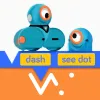Take a look inside 5 images
Blockly for Dash & Dot Robots
Pros: Students see code come to life and have lots of customization options for sounds.
Cons: Puzzles are very challenging and sometimes buggy, with little to no help.
Bottom Line: You can program robots with code blocks, with plenty of creative options and lots of fun.
Lesson plans are available on the Wonder Workshop website to supplement the Blockly app. Teachers can register for full access to all the lesson plans covering all content areas for grades K–5 for $60 per year. Use Blockly to introduce kids to an Hour of Code session or let kids explore programming as a center activity throughout the school year. Some classes may adopt Dash and Dot as class mascots, and teachers could find lesson plans online or create their own to integrate them and programs across the curriculum; kids could write stories about Dash and Dot's adventures and create a program to accompany it, for example. Lesson plans on the Wonder Workshop site include geography, graphing, and more.
Dash and Dot are a pair of robots from Wonder Workshop with five accompanying apps that help kids program the robots. Blockly introduces students to coding using visual blocks of code. Though the apps are free, the robots must be purchased either individually or as a package deal, ranging from $49.99 to $249.99. In Blockly, students work through a hands-on tutorial and then can complete puzzles where they have to write the prescribed programs. They can also create their own programs, including custom sounds, too, and save them in-app. The robot or robots kids are working with will need to be detected via Bluetooth by the app each time they play.
A Driving School lesson starts kids off, introducing them to the commands that drive the robots. Once kids have their license, they can complete themed puzzles, unlocking more as they advance, or create original programs. Dash and Dot can drive forward, backward, left, right, and turn. They can look different directions or toward a voice. They can light up in different colors and make different sounds, including custom-recorded sounds. Kids can add in other variables to make the robots respond to obstacles and other conditions, too.
With Blockly, students will work with programming concepts such as sequencing, events, loops, algorithms, conditionals, and variables as they drag and drop the code into place to control the robots. The larger robot, Dash, moves on wheels and can light up and make sounds. Dot, the smaller, is designed to be touched -- shaken, tilted, dropped -- and responds with lights and sounds.
While these big-eyed robots may be absolutely adorable and good for lots of laughs with their quirky sound effects, they're actually teaching kids logic and hands-on coding skills. The puzzles are sometimes buggy, and there's very little help for kids who get stuck. The hints just repeat the original instructions with slightly different wording and a bit of elaboration. The create-your-own projects are where kids can really learn and have fun -- experimenting, taking risks, and applying logic and creativity. The options available for sounds, lights, and movement make the possibilities for what kids can do with Dash and Dot almost endless.














